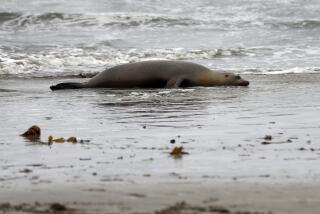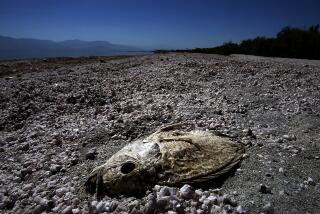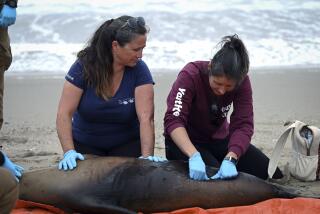Salton Sea Pelican Botulism Spreading to Other Birds
- Share via
A virulent outbreak of botulism that has killed or sickened 2,500 to 2,800 pelicans at the Salton Sea--including about 1,000 endangered brown pelicans--has begun to spread to other species of birds.
Although the die-off among pelicans is slowing, “it is getting worse in the shorebird population,” Salton Sea National Wildlife Refuge manager Clark Bloom said Monday. “It is affecting everything down here at the sea. . . . I’m sure more birds will die before this is over with.”
A sprawling, salty lake near the Mexican border, the Salton Sea is a major retreat for migrating birds, including dozens of species of waterfowl and shorebirds.
*
Wildlife officials have toiled in 115-degree heat to collect the carcasses, and an incinerator to dispose of them has been running 24 hours a day since the epidemic was discovered Aug. 15.
About 80 sick pelicans are being treated at hospitals set up by state and federal officials and local veterinarians.
“There are still sick birds coming and they are still dying, but it’s not in the volume we’ve had over the past couple days,” Bloom said.
Cathryn Converse, a federal wildlife disease specialist, said it is likely the birds are being exposed the the toxin through fish. The disease cannot be transmitted from bird to bird and instead is contracted through something they ingest--usually food or soil--and is reportedly not transferable to human beings.
A powerful windstorm swept the area on Wednesday and could have churned up toxins at the bottom of the sea, Bloom said.
“It takes the right conditions--warm temperatures, alkaline conditions--that is when it’s triggered to start growing and reproducing,” Converse said.
Botulism results in a painful death for birds. As they fall ill, they lose strength in their leg muscles and cannot hold their head up or fly. When they are near death, they are virtually paralyzed and often drown or die from dehydration or starvation.
*
The die-off could have a major impact on the West Coast’s population of brown pelicans, an endangered species that was nearly wiped out in the 1970s by the pesticide DDT.
Only about 5,000 to 7,000 brown pelicans--known for their distinctive S-shaped necks and their graceful skimming of ocean waves--breed in California annually, mostly on Anacapa Island in the Channel Islands. Larger numbers, though, breed in Mexico. Forty percent of the dead birds at the Salton Sea, or about 1,000, are brown pelicans.
In recent years, an estimated 200,000 other birds at the Salton Sea, especially grebes, have died suddenly and mysteriously in several die-offs. Botulism, however, was not to blame, and wildlife experts believe that a toxic form of algae, probably fed by fertilizer runoff from nearby farms, was the culprit.
More to Read
Sign up for Essential California
The most important California stories and recommendations in your inbox every morning.
You may occasionally receive promotional content from the Los Angeles Times.










